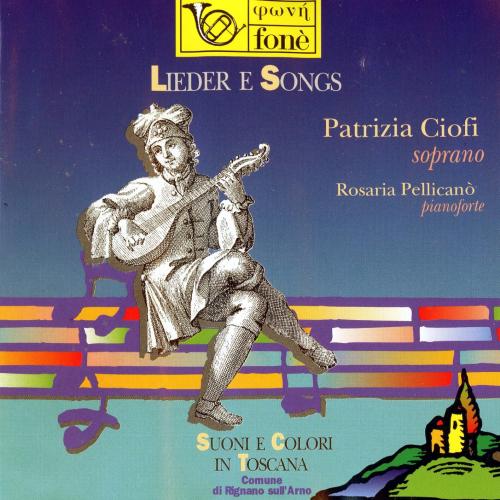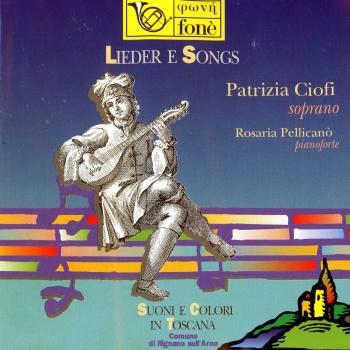
Lieder e Songs Patrizia Ciofi & Rosaria Pellicanò
Album Info
Album Veröffentlichung:
1997
HRA-Veröffentlichung:
18.01.2023
Label: fonè Records
Genre: Classical
Subgenre: Vocal
Interpret: Patrizia Ciofi & Rosaria Pellicanò
Komponist: Wolfgang Amadeus Mozart (1756–1791), Franz Schubert (1797-1828), Robert Schumann (1810-1856), George Gershwin (1898-1937), Leonard Bernstein (1918-1990)
Das Album enthält Albumcover Booklet (PDF)
- Wolfgang Amadeus Mozart (1756 - 1791): Abendempfindung:
- 1 Mozart: Abendempfindung 05:19
- An Chloe:
- 2 Mozart: An Chloe 02:53
- Trennungslied:
- 3 Mozart: Trennungslied 05:21
- Franz Schubert (1797 - 1828): Standchen:
- 4 Schubert: Standchen 04:15
- Gretchen am Spinnrade:
- 5 Schubert: Gretchen am Spinnrade 03:45
- Robert Schumann (1810 - 1856): Mondnacht:
- 6 Schumann: Mondnacht 03:39
- Der Nussbaum:
- 7 Schumann: Der Nussbaum 03:48
- Ich grollenicht:
- 8 Schumann: Ich grollenicht 01:42
- George Gershwin (1898 - 1937): Someone to watch over me:
- 9 Gershwin: Someone to watch over me 03:04
- I got rhythm:
- 10 Gershwin: I got rhythm 01:59
- The man I love:
- 11 Gershwin: The man I love 03:00
- Summertime:
- 12 Gershwin: Summertime 02:16
- Leonard Bernstein (1918 - 1990): West Side Story, Somewhere:
- 13 Bernstein: West Side Story, Somewhere 02:24
- West Side Story, Maria:
- 14 Bernstein: West Side Story, Maria 02:47
- West Side Story, Tonight:
- 15 Bernstein: West Side Story, Tonight 05:39
- Robert Schumann: Ich grollenicht:
- 16 Bernstein: Ich grollenicht 01:34
Info zu Lieder e Songs
The festival "Suoni e Colori in Toscana" (Sounds and Colours in Tuscany) has, during the past years, become an important event. It has gained the unconditional approval of music lovers for the originality of its contents and for the quality of the music it offers.
The album we are proposing, fully demonstrates our effort to highlight this cultural event. This is part of a vaster project to promote our area which is renouned for its many values and talents.
I wish to thank the publisher Fonè for his valuable and competent work, and I hope that this event will prove to be the first of many more. (Massimo Settimelli, Mayor of Rignano sull'Arno)
While strolling in a garden you can make a beautiful bouquet by picking any of its endless variety of flowers. This is exactly what the Lieder anthology did. It picked music coming from various musical and poetic sources born either as individual or as being part of a musical cycle and above all coming from different cultural times (even if this chronological period spans only half a century). What is exactly the Lied? It can be truly qualified as the overtly idealized expression of a state of being characterized by a regular melodic structure based on popular songs. One can thus achieve a definition which could, with referral to the historical period dealt with, be included in a good dictionary. But the Lied is above all something different. Its text, either by mentioning joy or sorrow, through a picture, an image of nature or daily life, achieves a fleeting tie with human existence. It lasts only an instant, it can vanish when mentioned or be changed by different subsequent moods. A timeless wish, longing for what was barely perceived or what never was.
Let's look at the titles of this anthology. We find three of the best Lieder by Mozart, all dated 1787. They all show an ante litteram approach to the expressive dimension which can itself be defined romantic. They are a leading path in the itinerary of the Lied because they mark the transition between the humble sphere of home usage and the splendour of artistic music. They are pieces that are not always based on texts of high poetic content but the music makes the miracle and it makes them become highly passionate like Abendemphindung (a foreboding sunset). Just like the touching love song for Cloe, in which the opera air still floats with delicate movements. Till the Trennungslied which surges to remind how oblivion can cancel in a few moments what love has given for years. ...
Patrizia Ciofi, soprano
Rosaria Pellicanò, pianoforte
Mauro Ceccanti, direction
Patrizia Ciofi
Die aus dem toskanischen Casole d’Elsa stammende Patrizia Ciofi zählt heute zu den vielseitigsten Sopranen mit einer bereits über fünfzig Aufnahmen umfassenden Diskographie. Geboren 1967 und ausgebildet im benachbarten Siena, gab sie ihr professionelles Debüt im Jahr 1989 am Teatro Comunale in Florenz, dem sich Engagements in weiteren italienischen Häusern, zunächst vornehmlich in Mozart-Partien, wenig später auch in Verdi-Opern, anschlossen. Ihr Rollendebüt als Lucia di Lammermoor in Savona (1996) markierte ihren endgültigen Durchbruch; es folgte eine Einladung an die Mailänder Scala, wo sie 1997 mit bahnbrechendem Erfolg die Violetta in »La Traviata« sang. Weitere wichtige Debüts an internationalen Häusern wie der Opéra Bastille in Paris, dem Royal Opera House Covent Garden und der Lyric Opera Chicago schlossen sich in den folgenden Jahren an, gefolgt von ihrem lang erwarteten Einstand an der Wiener Staatsoper im Jahr 2008. Einen Namen gemacht hat sich Ciofi im Laufe ihrer Karriere mit einer Vielzahl von Rollen zwischen Alter Musik, Mozart- und Belcanto-Figuren, als Gilda oder Mimì und vor allem auch im französischen Fach, in dem sie Maßstäbe setzt als Marie in Donizettis »La fille du régiment«, in der Titelpartie von Giacomo Meyerbeers »Dinorah«, als Isabella in dessen »Robert le diable« und vor allem als Marguerite de Valois in »Les Huguenots« oder auch als Leila in Bizets »Perlenfischern«, Juliette in Charles Goundos »Romeo et Juliette«. 2017 gab sie ihr Rollendebüt als Bellinis Norma in Liège und begeisterte in der Spielzeit 2018/19 als Primadonna in Gaetano Donizettis komischer Oper »Viva la Mamma« in Genf.
Booklet für Lieder e Songs










